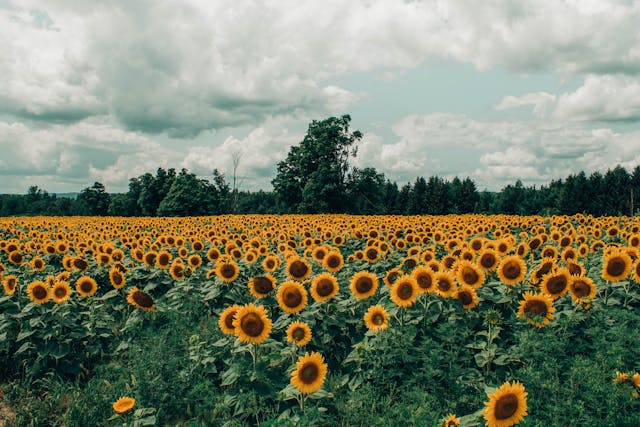
How can sunflowers clean up radiation? They take the radioactive isotopes out of the soil and combine them into their stems and flowers.
There is radiation all around us, all of the time. Radiation is simply energy that moves from one place to another. The light energy that bounces of a rose and hits our eyes is radiation. The heat we feel from a black car seat in direct sunlight is radiation. The signal our radio is picking up so that we can listen to music is radiation. It is all around us. Most of the radiation we are exposed to is not harmful. However, some of it is. The difference comes in non-ionizing radiation and ionizing radiation. Non-ionizing radiation has less energy than ionizing radiation. All of the atoms in the world, and those in our bodies, have electrons flying around them. Non-ionizing radiation, such as visible light and radio waves, doesn’t have enough energy to affect these electrons. It passes through us harmfully. Ionizing radiation does have enough energy to affect these electrons. Ionizing radiation, such as X-rays, has so much energy that it can strip the electrons off atoms, changing them at the atomic level. This causes damage to our cells, mutations, and potentially even death.
Different sources produce different radiation. When sunflowers are used to clean up radiation, it is usually after a nuclear accident, so let’s look at the sources of radiation released from a nuclear accident. After a nuclear disaster, we find Tritium, Strontium-90, Iodine-131, Cesium-134, Cesium-137, and Plutonium-239. Some of them are more dangerous than others, but they are all pretty bad. If they get into your body, they can accumulate in the organs and bones, causing lots of damage. They also hang around for a pretty long time. All of these sources of radiation have a half-life, but some of them last longer than others. Their half-lives differ on whether they are in the environment or in your body, as well. These sources of radiation are often scattered far and wide by a nuclear disaster and they can be carried on the wind before settling to the ground. It would be nice if they just disappeared when they hit the ground, but they don’t. They sink into the soil and settle down to wait to decay, releasing dangerous radiation the whole time. And that is where sunflowers come in.
All plants pull nutrients out of the soil to grow. Different plants need different nutrients, but they generally pull nitrogen, phosphorous, and potassium up through their root systems. Plants also need a small amount of iron as well. The roots of the plant stretch out into the soil and they make smaller and smaller offshoots. Each part of the root system has thousands of hairs that increase the surface area of the roots. The plants can absorb water through these roots by osmosis, and they take in minerals with that water. The plants then move these nutrients around to where they are needed and use them to create new cells and grow.
Sunflowers do this too, of course, but they are known as a hyperaccumulator because they pull heavy metals out of the soil and store them in their cells. Other plants can do this as well, but sunflowers are particularly able to pull radioactive heavy metals, such as Cessium-137 and Strontium-90 out of the soil. Both of these metals are very similar to potassium and the sunflower hoovers them up without realizing the difference. All of the radioactive material gets stored in the plant and then the plants are harvested and incinerated. This leaves the heavy metals behind, and they can be disposed of safely. Sunflowers were planted after the Chernobyl disaster, and they have done a wonderful job of cleaning up the soil. They can’t get all of the radioactive material out, but they can get a lot.
They are not only useful after nuclear disasters, but they can also be used to clean up regular pollution. They have been used around the old car factories in Detroit. There are a lot of metals in the soil near these factories, such as lead, nickel, and zinc. Sunflowers were planted and they pulled a lot of those out of the ground, making it much easier and cheaper to finish the cleanup.
Sunflowers aren’t perfect, though. Some species of sunflower absorb more metals than others and some absorb different kinds of metals. Ideally, planting a variety of sunflowers and other hyperccumulators, such as Indian mustard and some ferns, in the same area will have the best results because it will play to the strengths of the individual plants. And this is what I learned today.
Photo by Designecologist: https://www.pexels.com/photo/bed-of-sunflower-1287124/
Sources
https://theworld.org/stories/2013/08/15/stub-5275
https://www.nj.gov/dep/rpp/llrw/download/fact05.pdf
https://www.env.go.jp/en/chemi/rhm/basic-info/1st/02-02-04.html
https://www.iaea.org/newscenter/news/what-is-radiation
https://en.wikipedia.org/wiki/List_of_hyperaccumulators
https://www.rhs.org.uk/advice/understanding-plants/how-plants-absorb-nutrients
